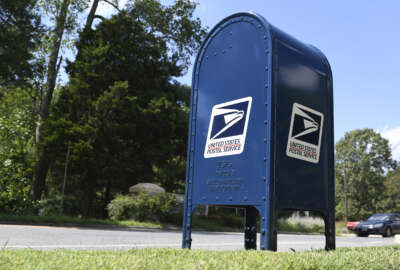Your mail carrier a little grumpy lately? We might know why
The Office of Inspector General took a detailed look at how employees view the Postal Service as employees. Priscilla Lee is a research analyst with the OIG and...
Best listening experience is on Chrome, Firefox or Safari. Subscribe to Federal Drive’s daily audio interviews on Apple Podcasts or PodcastOne.
It’s not just a slogan. They really do deliver mail through the gloom of night, and in rain and snow. But employees of the U.S. Postal Service have mixed feelings about their employer. The Office of Inspector General took a detailed look at how employees view the Postal Service as employees. Priscilla Lee is a research analyst with the OIG and talked about the findings on Federal Drive with Tom Temin.
Interview transcript:
Priscilla Lee: At the OIG, we were interested in examining views of the Postal Service as an employer. And to do that we had looked at all sorts of information, including surveys. We focus mainly on online ratings and reviews on websites such as Glassdoor.com and Indeed.com, which have their own surveys there. We also looked at postal surveys, which has been administered monthly and annually. And then we examined postal data on turnover and conversion, which includes everybody, it’s the entire universe there of postal workers.
Tom Temin: So this was basically then a survey of already existing research you kind of gathered all together.
Priscilla Lee: Exactly, exactly. The Postal Service’s gracious in sharing some of their information. And there is stuff that we had gathered ourselves with our team from Glassdoor.com, and a little bit from Indeed.com as well.
Tom Temin: Yeah, Glassdoor can be harsh on employers. And did you do any personal interviews with different classes of employees just to test your hunches?
Priscilla Lee: That was actually outside of the scope of our project, although that would have been very interesting. But we did look at reviews on those websites, which allow employees a chance to speak in their own voice and talk about what they’re really feeling, which is a little bit different from just surveys where you click one response, and it may or may not be exactly how you’re feeling. We thought that might be a great way to kind of allow them to air how they’re feeling and get a good idea of what their experience was like.
Tom Temin: And what is the general finding here? How do employees find the Postal Service as an employer?
Priscilla Lee: So our findings were mixed. There was some good news there, and there was also some bad news. We found that on online websites, a lot of the reviewers were praising the high pay, employees felt a clear sense of purpose at work. And this was also reflected in the postal surveys. So almost nine out of ten respondents understood how their work helped the Postal Service succeed. Another eight out of ten thought that the Postal Service was a place where they could build their career. So clearly, these employees were resonating with the postal mission. But then there is the bad news, which is, in general, the Postal Service is actually rated more poorly than other comparable organizations on sites like Glassdoor and Indeed. And when I say ratings, I mean their scores out of a possible five stars. So you can go on and you can rate a place one star, two stars or three stars all the way up to five stars. But the Postal Service is often rated below, say, UPS or FedEx. We also compare them against other government organizations such as Social Security Administration, or the VA. And in each of those cases, they are actually doing poorly compared to these other organizations. We found that three quarters of the respondents were unengaged, or actively disengaged. And that was a number that was fairly consistent over the years of our scope. So when we saw ratings like that, it made us want to dig a little bit deeper, and we began to look for change over time, during our scope period, which was fiscal years 2016 to fiscal year 2021.
Tom Temin: Did the scores vary across the types of employees? Were you able to discern, say, whether letter carriers had one view and people working inside the sorting facilities had another view, and management down there on L’Enfant Plaza and throughout the country had a third view?
Priscilla Lee: That is a great question. What triggered that was when we were looking through the reviews that were on these websites, some of the most frequently occurring phrases are things like long hours and work-life balance, and there are no benefits, and then feeling that the no benefits made us think that sounds like non-career folks. So if you wanted to apply for the Postal Service, for instance, you would start as a non-career employee, which means that your hours wouldn’t be as steady and you would have fewer benefits, like you might not have access to health care, for instance. So then we took another look at those statistics, and we dug a little bit deeper. And that’s when we started to see, especially when compared to non-career employees, so those were starting out against the career employees who make up the bulk of the Postal Service. We found there was this clear difference. So when we look at star ratings, for instance, courier employees gave higher ratings to the Postal Service than non-courier employees. And that was for every year, we found that the person who recommended the Postal Service, that when also there was a clear difference between courier employees who said that they would, there were more career employees that they would versus non career employees who said they wouldn’t.
Tom Temin: Alright, so much for the contracting way of life for the gig economy, I guess. We’re speaking with Priscilla Lee, she’s a research analyst in the Research and Insights Solution Center at the Postal Service Office of Inspector General. And you were going to mention how the results have changed over time. What are the trends here in terms of how much people love their employer at the Postal Service?
Priscilla Lee: Yeah, that one, there was a little bit of bad news there. So we did find that there was a lot of decline over those years. For instance, in general, the yearly average ratings on Glassdoor declined over time. And then I also talked about whether you would recommend your employer or not. For instance, we found that that number has declined from 40% who said that they would at the beginning of the scope all the way down to 25% now. And this is something that was reflected in the postal surveys as well. So we found that strong positive sentiments at the beginning of the scope had also declined. So an example of that would be a 17 point decline in people who strongly agree that they haven’t thought about leaving. That also actually holds true in the data as well. So people vote with their feet, right. When they’re unhappy, they might turn around and decide to leave where they’re working and look for another job. So we did dig into some of the postal data to see what turnover rates looks like. And what we found was, it’s great that you would ask about career versus non-career, there was this big difference in career folks versus non-career folks. In terms of the turnover, we found that turnover has been consistent. So that one, there hasn’t been much change over time. With career folks, there are only about 6-to-8% of the workforce that was leaving every year, and a huge chunk of that was just due to retirement. So when you take out retired folks, then you only have about 2% of the force that’s leaving. But then when you look at non-career turnover, it was about 36-to-43% of non-career folks who are leaving, and that’s way above the national turnover rate of 25.5%. And that’s a number that has fluctuated over time a little bit. And the Postal Service has been working to lower that to a performance of I believe it’s 34%. But they haven’t quite reached it yet.
Tom Temin: Alright. And the question I had too, I think you’ve kind of answered indirectly. And that is, were you able to adjust for what might be a bias in a source like Glassdoor, where maybe just the disgruntled would even bother to go to Glassdoor in the first place, the self selecting people that are unhappy.
Priscilla Lee: We did kind of try to control for that a little bit by taking a look at what else is out there, right. We looked at postal surveys and looked at those results. We looked at postal data sets. But what we found interesting with these websites was that it allows us to triangulate the information that’s out there, right. And so it gives us further confidence in the data that we’re seeing already and that postal is already seeing. But then, even when you set aside the question of these online websites, and people are kind of disgruntled, and maybe that’s why they’re coming on — even if you’ve kind of set that aside, one of the reasons we did look at those websites is because a lot of people turn to these websites, right, when they’re looking for a job. In our background research, we’ve came across a survey that said something like 85% of respondents look at online reviews when deciding where to apply. And I think even a third said that they declined a job offer because of negative reviews. So we thought it was important to take a look at online websites so we could see what prospective employees might think about what it’s like to work for the Postal Service. They don’t have access to the postal surveys that we were looking at, so if they were deciding where to work, they might come here.
Tom Temin: Yes, you don’t want to be like the reviews for ginsu knives on Amazon where only the people that the dole ones are reporting in, or something like that.
Priscilla Lee: Exactly.
Tom Temin: Did you have any recommendations for the Postal Service to become a better employer and make those trend lines reverse?
Priscilla Lee: So in this paper, we did not offer recommendations but we did want to know that the Postal Service is aware of these issues. They have made a strategic goal in their 10 year plan to tackle, for instance, non-career turnover. So they’ve actually already implemented a few initiatives to increase employee retention, and that included things like ensuring that training is completed on time and providing frequent check in with your supervisor. I think they’re also going to cap hours at a maximum of 40 hours during the first 30 days. And they’ve also been working with unions to improve the conversion process. And that’s where you convert from non-career status to career, and then you get access to all those benefits. For instance, CCAs, which are city carrier systems, they now have the opportunity to automatically convert to a career position after two years.
Copyright © 2024 Federal News Network. All rights reserved. This website is not intended for users located within the European Economic Area.
Tom Temin is host of the Federal Drive and has been providing insight on federal technology and management issues for more than 30 years.
Follow @tteminWFED






